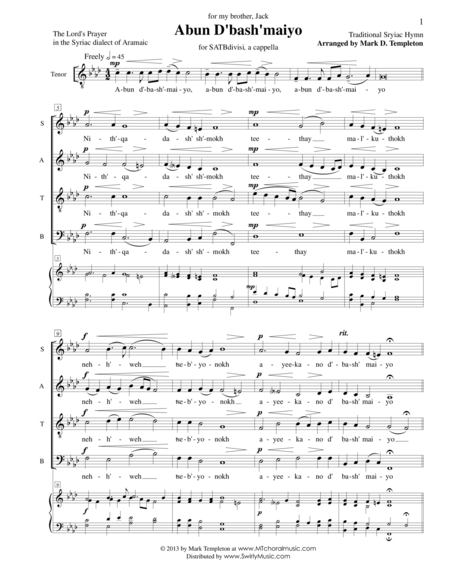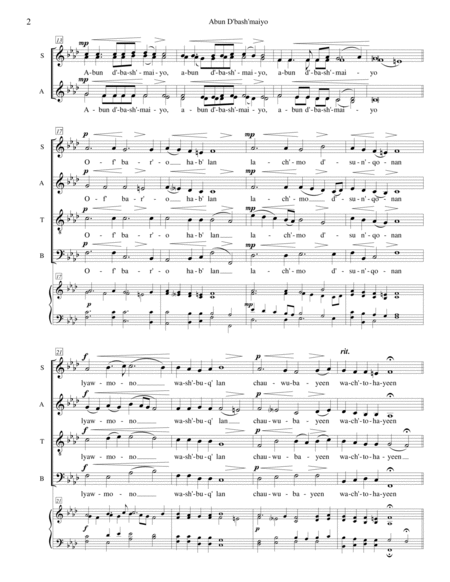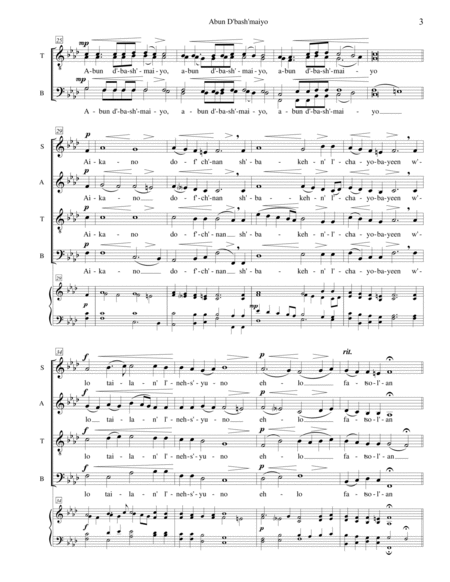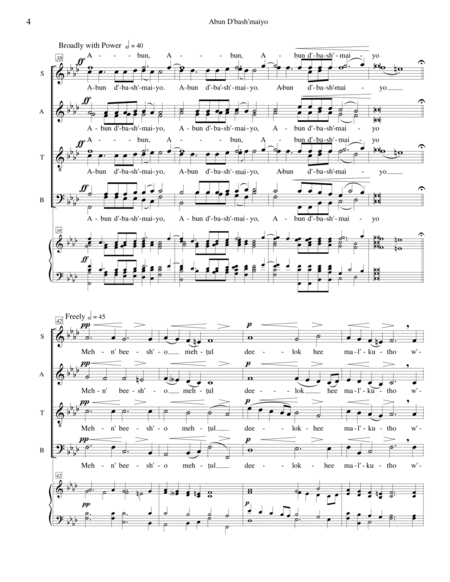Abun D'bash'maiyo
 Instant Download
Instant Download
Details
Description
SKU: A0.864399
Composed by Traditional Syriac Chant. Arranged by Mark D. Templeton. A Cappella,Contemporary,Folk,Sacred,World. Octavo. 7 pages. Mark Templeton Choral Music #2024895. Published by Mark Templeton Choral Music (A0.864399).Composed by Mark Templeton for SATB divisi chorus a cappella. Since the dawn of the first century, the text from the gospel of Matthew 6:9-13, known as the Lord’s Prayer, has inspired many musicians across the globe from Palestrina to Schubert to Duruflé and countless modern composers. The vast collections of Western plainchant and Byzantine chant also include the Lord’s Prayer in their repertoire. Probably the most unheralded version comes from the Beth Gazo, a collection of liturgical chants and hymns of the Eastern Syriac Orthodox Church. The Beth Gazo (The Treasury of Chants) is the Eastern Church’s equivalent of the Liber Usualis of the Roman rite. The roots of the collection can be traced as far back as the second century with Ephrem the Syriac contributing the bulk of the chants. It is supposed that thousands of chants existed in the original collection, but since they were only passed down through an oral tradition, only 700 or so have survived. Only in the late twentieth century have musicologists begun to preserve these in musical notation. The Abun d’bash’maiyo (Our Father) is one such chant that has survived. When I set out to compose the Lord’s Prayer for my Compline, I wanted to try something different. I searched until I came across this version from the Peshitta text in Syriac, one of the dialects of old Aramaic. Historians and biblical scholars generally agree that Jesus would have spoken Aramaic. I thought it would be wonderful to compose something using the language, or near language, of Christ. I decided to use the actual chant from the Beth Gazo as my melody. The melody uses the Arabic maqam, Nahawand (نهاوند), which is basically a melodic minor scale found so prevalently in music from the Fertile Crescent. The chant is sung like a hymn with four verses repeating the same melody. The only words that are not traditionally used as part of the chant is the title, Abun d’bash’maiyo. I set these words as a kind of intoning chant before each verse with the last intonation using the full divisi and power of the choir. This meditative and somewhat surreal setting is well suited for any sacred service or for a multi-cultural concert. Mark Templeton, born 1974, is an American choral composer, conductor, and countertenor. Templeton’s music has been performed across the world at various international festivals and ACDA conventions. Some of his music is published by Santa Barbara Music Publishing, and he has recently started to self-publish. He teaches and resides with his wife, Becca, at West Nottingham Academy in Colora, Maryland, the oldest boarding school in the United States. He also enjoys coaching, playing, and watching soccer when he is not working. He is available for commission upon request.
This product was created by a member of ArrangeMe, Hal Leonard’s global self-publishing community of independent composers, arrangers, and songwriters. ArrangeMe allows for the publication of unique arrangements of both popular titles and original compositions from a wide variety of voices and backgrounds.
Digital Downloads are downloadable sheet music files that can be viewed directly on your computer, tablet or mobile device. Once you download your digital sheet music, you can view and print it at home, school, or anywhere you want to make music, and you don’t have to be connected to the internet. Just purchase, download and play!
PLEASE NOTE: Your Digital Download will have a watermark at the bottom of each page that will include your name, purchase date and number of copies purchased. You are only authorized to print the number of copies that you have purchased. You may not digitally distribute or print more copies than purchased for use (i.e., you may not print or digitally distribute individual copies to friends or students).




 Share
Share